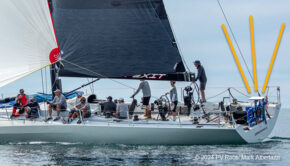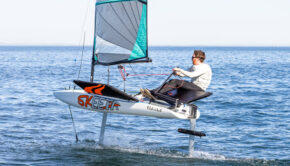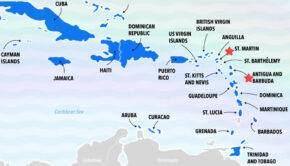Can a computer learn to sail an Optimist with AI?
Published on November 30th, 2023
Bill Gates once said, “Be nice to nerds. Chances are you’ll end up working for one.” The book ‘Unnatural Selection: Why The Geeks Will Inherit The Earth’ analyzes the impact of technology on human evolution and the rise of the geek class.
The problem for sailing is, just because emerging technology may function better than people, should we let it? Should we replace some of the mental challenges for sailors, and reduce them to passengers? Onboard instrumentation is already doing that, and now the Maritime Research Institute Netherlands (MARIN) has gone a step further.
As one of the leading institutes in the world for hydrodynamic research and maritime technology, they asked the question: Can a computer learn to sail an Optimist with Artificial Research? Here is their update:
Put a child in an Optimist and it will learn how to sail intuitively, without understanding the details of aerodynamics and hydrodynamics. One year ago, that inspired MARIN’s AI Sail team to take up a challenge: can a computer learn to do the same with the help of AI? On November 24, it was the moment of truth, during a demonstration in our Offshore Basin.
The background of this challenge is an important one: what can artificial intelligence and machine learning contribute to a cleaner, smarter, and safer maritime world?
Most maritime prediction methods are based on a model-based approach: physics-based models are combined in a computational model and validated in model tests and reality. With AI Sail, we want to demonstrate the possibilities of data-driven methods, where the physics are not explicit in the model, but implicit in the data.
In simple terms: if children can learn how to sail an Optimist without knowledge of aerodynamics, hydrodynamics and oceanography, an AI-algorithm should be able to learn the same.
The AI Sail team consisted of a broad mix of MARIN specialists: AI/machine learning, digital twinning/time domain simulations, sailing/wind assist, and model testing. AI Sail is an open-innovation project, with workshops for maritime clients and with student’s involvement of TU Delft.
They were able to develop their own AI sailing ‘agents’ (‘digital kids’) based on reinforcement learning (RL) with digital twins of the Optimist and our Offshore Basin in our time domain simulation framework XMF. In the meantime, our model test engineers had modified our Optimist with computer-controlled rudder, sheet and weight control and checked all necessary communications in the basin.
“It was very exciting and great fun as well,” shared Fanny Rebiffé, AI-specialist at MARIN. “Like with real kids on a lake, some RL-agents learned faster and better. Regularly an extra turn had to be made. Sometimes the Optimist stopped head into the wind. But working hard with the rudders and the shifting weight, several agents were very effective in getting wind in the sail again. So our ‘digital kids’ were ‘creative’ in solving their problems.”
Dr. Hannes Bogaert, leader of the AI Sail team added, “The maritime sector is watching this technology with great interest. The challenges to design and operate ships are increasing. Emission free ships and operations require more complex propulsion, power, and energy systems.
“The damage caused by accidents at sea can be enormous. Society is less willing to take risks and adequately responding to risk situations on board is necessary. Offshore sustainable energy requires complex installation and maintenance operations at sea. People need to be better supported. During design and on board.
“Through the application of AI, we can make many systems smarter and better support design and operation.”









 We’ll keep your information safe.
We’ll keep your information safe.